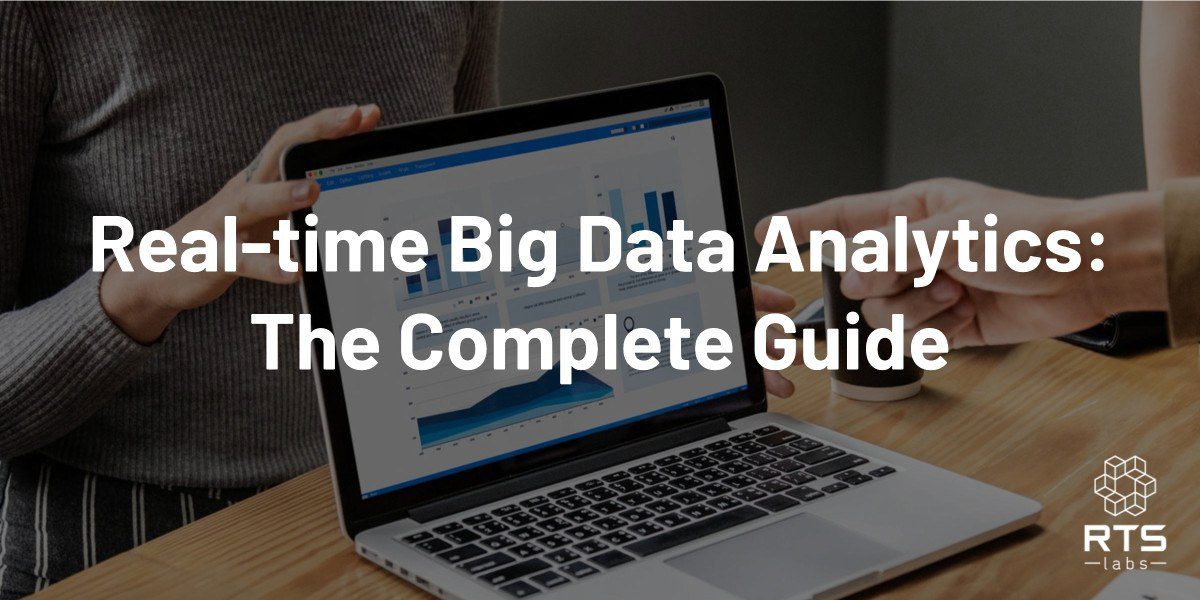Big data may be a big buzzword, and real-time analytics may seem like a pipe dream for many up-and-coming enterprises. However, both things are much needed by most businesses – and both things are more attainable than you think, as we explain in Real-time Big Data Analytics: The Complete Guide.
Don’t write off big data just because its popularity makes it sound like a cliché. And don’t dismiss real-time analytics because they don’t seem realistic for your enterprise at first blush.
Real-time big data analytics can hold a huge amount of promise for business efficiency and profitability. Here’s how you can harness this powerful set of information for your own benefit at any stage of business growth.
Real-time big data analytics: The natural next step
Big data analytics have been around for a while. Now, the logical next step is for businesses to apply this powerful information in real time to make better business decisions overall.
For example, big data most likely helped Amazon decide to buy Whole Foods, as the tech giant gained critical insight about the fresh food market. Citi Ventures (innovation arm of Citi) made a strategic investment in a data science company to speed up fraud detection (using real-time analytics, naturally). And retailers regularly harness data and apply it to accurately predict holiday sales, staying ahead of both their competition and their own customers’ demands.
“The phrase Big Data is not just a new buzzword, it’s something that arrived slowly and captured the entire arena. The advent of Big Data as a concept has made it possible to store, process, and analyze these large pools of data to get intelligent insight, nad perform informed and calculated decisions. These decisions are driving the recommendations, growth, planning and projections in all segments of the economy. Architectural flavors such as SaaS and PaaS [are] … making Big Data synonymous with low cost, scalable, highly available, and reliable solutions that can churn huge amounts of data at incredible speed.” ~ Sumit Gupta, Real-Time Big Data Analytics, p. 2
This isn’t something to keep your eye on for the future. It’s happening now, and enterprises of all shapes and sizes will do well to consider how real-time big data analytics can improve everything from time-to-market to market insights.
You can use this guide to dive into your main ‘what’ questions about real-time big data analytics, including:
- What do big data analytics, and what does applying analytics in real time bring to the table?
- What benefits are there to using real-time analytics for your enterprise?
- What does setting up real-time big data analytics look like?
- What does big data analytics look like in the real world?
- What are the challenges in setting up real-time big data analytics – and how can you overcome them?
The real definition of real-time big data analytics: What is it and what can it do for you?
While putting real-time big data analytics into practice may be complicated, defining it isn’t all that difficult.
The true definition of real-time big data analytics includes the three most common data terms: data science, big data and data analytics. The way the three arms work together is best explained in this archived RTS Labs blog about demystifying data terms: “So, if data science is the methodologies, and big data is the massive amounts of data your business acquires, then data analytics is how we make sense of it and apply it to the problems we want to solve.”
Add to that the ability to fetch and analyze data the same minute it’s created, and you have real-time big data analytics.
The lazy definition:
Real-time big data analytics is analyzing big data in real time.
The real definition:
Big data analytics allows enterprises to use large data sets to uncover information about their processes, customers, market and more. Architecture that analyzes and applies big data analytics in real time simply means pushing data through analytics software as it arrives. The combination makes actionable insights faster, allowing a shorter and better decision-making process.
In other words, the definition of real-time big data analytics is tied up in both its use cases and its benefits. If you know how big data works and how real-time analytics work, then you will mostly like see the inherent value of real-time big data analytics – thus the rise in popularity, too!
On the other hand, the question of how real-time analytics work with big data is sometimes not as clearly defined. What is the benefit of bringing the two together – and what do they offer modern enterprises? Another definition helps us glean some insight into these questions:
“Real time big data analytics is referred to the process of analyzing large volume of data at the moment it is produced or used.
It is the process of extracting valuable information for the organization using as soon as its stored/created within big data repository/infrastructure.” [sic] ~ Techopedia’s definition of real-time big data analytics
Ignoring the awkward phrasing of this definition, the concept behind it is strong. The critical part here is in that second phrase: valuable information is extracted the minute it enters an existing big data infrastructure. That’s the true value in real-time analytics with big data.
More specifically, there are a handful of elements critical to real-time big data analytics. These include:
- It is most helpful in industries and enterprises that create and deal with a huge amount of data on a daily or weekly basis.
- The architecture is designed to fetch data the moment when it is run; then the system utilizes big data analytics algorithms to provide insight on the fresh data.
- To handle the large amount of data required for real-time analytics, the process will create batches of data to be sent to and mapped in distinct compute engines; results are then compiled for analysis.
- Big data insights are typically delivered in real time, using an analytics software dashboard, which brings a visual element to the analysis.
There you have it: the foundation of what real-time big data analytics are and what enterprises are able to use them for.
But what about the ‘why’ and the ‘how’? Why should enterprises start using real-time analytics with their big data? How does the architecture work and take shape in the real world?
Why use real-time analytics?
There’s no question that introducing real-time analytics to the big data you’re using can be a big undertaking.
Doing so requires more computing power, more operational resources and an overhaul of how your organization operates. But getting your enterprise up to speed is almost certainly worth it, particularly as you look for ways to modernize legacy systems and streamline everything from system updates to daily operations.
“How much money does a business lose when its leaders don’t have instant insight into their company’s data … This is a question every Chief Information Officer should be asking and evaluating their current and future information systems on. As innovators race toward real time, the wise CIO is one who embraces the fastest and most efficient means of analyzing data.” ~ Jindou Lee, “Adopt real-time data analytics or get left behind,” CIO
Using real-time data analytics gives you a competitive advantage
With real-time insight into your market, your audience, and your competition’s activities, you can stay a step ahead.
For example, if a competitor lowers their prices or shifts their marketing strategy, real-time analytics lets your business analysts see the change immediately and make specific recommendations to management.
On the backend, using these kinds of tools can translate into IT cost savings. In the short term, implementing big data tools is certainly expensive. However, the payoff over the long run is that the processes will simultaneously free up precious IT resources and provide the insights necessary to improve your profit margins.
The bonus internal benefits to your enterprise
Similarly to implementing a DevOps philosophy or using containerized applications in your next enterprise web platform, taking advantage of big data in real time means a lightened load for your whole team.
Instead of developers, analysts and managers wasting time on the back-and-forth necessary to get the required insight from an initial query, a tech stack supporting real-time big data analytics streamlines the entire process for everyone.
And the benefit doesn’t just apply to your business analysis segment – real-time analytics can also improve operations from the ground up. Take these examples that the strategic firm Bernard Marr & Co. gives of applying data in real time:
“Big data is also increasingly used to optimise business processes. Retailers are able to optimise their stock based on predictions generated from social media data, web search trends and weather forecasts.
“One particular business process that is seeing a lot of big data analytics is supply chain or delivery route optimisation. Here, geographic positioning and radio frequency identification sensors are used to track goods or delivery vehicles and optimise routes by integrating live traffic data, etc. HR business processes are also being improved using big data analytics.”
Finally, real-time data can minimize risk for the enterprise as well. The tech company that identifies a leak in a matter of minutes, for example, can react much better than one that only sees the exposure hours later.
Real-time analytics architecture
Since using real-time analytics with big data requires handling many queries and a huge amount of data, the architecture operates on a similar philosophy to containerized applications in the cloud. Containers are designed to both navigate complex systems and automate application deployment at scale. Similarly, real-time analytics architecture is about batching data (into blocks, semantically if not architecturally similar to containers) and mapping it for faster analytics.
Generally, real-time big data analytics have four layers: the decision layer, integration layer, analytics layer and data layer.
The data layer serves as the foundation. It’s what is being analyzed. This layer involves your database management system of choice, such as NoSQL, Hbase, or Impala. Alternatively, you can utilize unstructured data in Hadoop. Data tools, such as Hive, Apache Storm and Apache Spark, are all useful at this level.
The analytics layer works as a production environment for the real-time and dynamic analysis of the data from the layer below. It also includes a development environment where developers can build out analytics models to be put to use.
At the integration layer, enterprise DevOps teams can utilize the APIs necessary to hold the end-user dashboard, the analytics engines and the data layer all together.
Finally, the decision layer in the real-time big data analytics stack includes dashboards specific to the real-time analytics project and business intelligence software. At this level, the end user (i.e., business analytics and C-suite executives) get to see the data.
To handle the large amount of data required for real-time analytics, the process will create batches of data to be sent to and mapped in distinct compute engines. Results are then compiled for analysis in the dashboard. This is particularly helpful when using unstructured data, since it can be run through distinct compute engines and then mapped into structured data in real time.
Tools, such as Hadoop, MapReduce, Hive and Impala, have made this possible. Mike Barlow raises a good point when looking at how data was used circa 2007 compared to today:
“Back then, you had to know the kinds of questions you planned to ask before you stored your data … Today, you are much less likely to face a scenario in which you cannot query data and get a response back in a brief period of time. Analytical processes that used to require month [sic], days, or hours have been reduced to minutes, seconds, and fractions of seconds.”
The uses for real-time big data analytics in the real world
It should be abundantly clear by now that big data analytics play an important role for most modern enterprises. But what does real-time analytics look like in practice – particularly when putting huge amounts of data to use?
According to Bernard Marr & Co. again, big data is being put to excellent use across different areas in the business world:
- Understanding and targeting customers to optimize the customer experience: Using big data, companies can create predictive models of demand, pricing, trends and more. In real time, companies can get a good idea of everything from sentiment to potential problems.
- Optimizing business processes: Data drives improvement in everything from logistics to HR practices. Combine the IoT with real-time analytics and business analysts can suddenly get very specific insights from large sets of data – insights that can then be applied to gain greater efficiencies across the enterprise.
- Optimizing device performance: When combined with machine learning, big data analytics can improve the devices that are getting ‘smarter’ every year. With real-time analytics, these machines can put gathered data to good use immediately.
In addition to these three areas, what we’ve also seen when working with clients is that they can use big data to optimize finances. Big data can be plugged into predictive models and programs in real time, informing decisions on everything from budget to investments.
These use cases span many industries, including:
The inclusion of all these industries shows just how much promise real-time big data analytics holds.
But what about the challenges in implementing real-time big data analytics?
The challenges of real-time analytics
One of the potential issues that a CIO or business manager may face when implementing real-time analytics for big data is software architecture that is irrelevant to the way you’ll be using the data.
“A well-designed architecture is a critical success factor, so pay special attention to the fundamental architectural issues,” Irene Makaranka writes at online resource TDWI. “A typical architecture is a good foundation, but it can be further tailored to achieve better performance.”
In other words, big data analytics is far from plug-and-play – particularly when implementing real-time analytics. Some enterprises may need to run both real-time and offline analytics, for example. Data spikes are unique to each enterprise and should be accounted for. The models and alerts should be built in as well. Often, notes Makaranka, this requires a professional consulting team that can design an architecture tailored to the needs of each enterprise.
Another challenge when implementing real-time analytics with big data has more to do with the organization: internal resistance to change and incongruent internal processes. Employees could be resistant to changes to familiar processes. Business managers could be resistant to the budget. Even without these typical barriers, CIOs still have to figure out how to make the transition to a new way of querying and providing relevant information from big data.
But these challenges won’t likely remain a barrier for many enterprises for long. As Mike Barlow at O’Reilly concludes:
“As information technology systems become less monolithic and more distributed, real-time big data analytics will become less exotic and more commonplace. The various technologies of data science will be industrialized, costs will fall and eventually real-time analytics will become a commodity.”
In other words, as everyone from the C-suite to the break room sees the improvements across the enterprise (AKA the classic “what’s in it for me” moments), resistance is likely to start to fade away.
One promising way to mitigate these challenges is to partner with experts in data science and related enterprise applications to get the most out of a new big data project. By partnering with a development team with practical experience in big data best practices, architecture, and applying real-time analytics, you are more likely to find the long-term benefits of real-time big data analytics.
Your next successful data initiative starts with a strategy and a plan. Need some help getting there? Give the RTS Labs team a call just to get the conversation started. We’re happy to go over all your initial questions – so you’re set up for success from the get-go.






